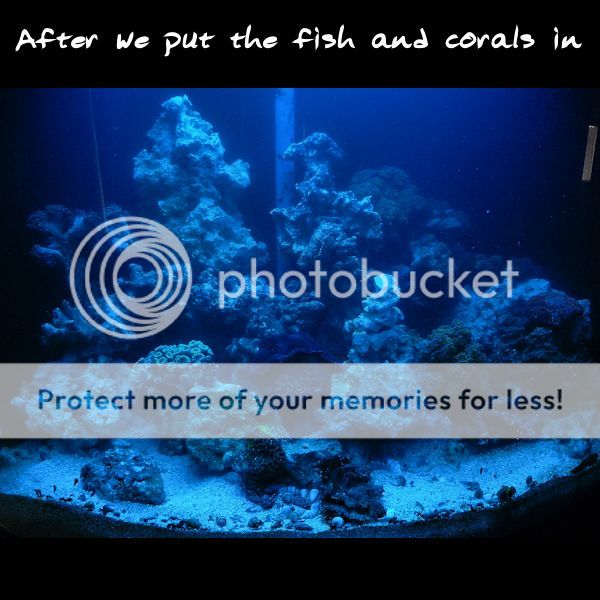After the rock setup, under actinics only: 
This is how the tank is for an hour before main lights come on and an hour after they go off: this is actinic (blue) light, which is high-energy light that penetrates deep. The fish have headed for their nooks in the rocks.

Are LEDs suitable for tank lighting, or is the lighting a small-enough fraction of tank maintenance that it doesn’t matter?
That’s a complicated matter: some LEDs are adequate for reef, some for fish-only, and some for fresh-water planted. You have to work out your situation (and rockwork!) and coral placement with what’s called a par meter, arranging sufficient light to get to them. The same would go for lighting a room, where you hope to have adequate light for various points of the room. LED is highly directional, and rather fragile. I run a 250 W 10000 kelvin metal halide and dual fluorescent HO actinic in the marine tank, reaching about 3/4 of the way to the bottom of the 36″ deep tank. The freshwater planted tank uses a simple Marineland LED.
That very much reminds me of scenes with the t’ca/chi and knnn, all the weird undersea-like fluorescents and such. Which of course was intentional. But now I see you have this around you constantly, an “alien ecosystem” with water-breathers instead of air-breathers or methane-breathers. The methaner scenes also remind me of footage of ocean-floor ordinary sea life or of thermophilic thermal vent life, very strange indeed. Really neat stuff.
As a kid, heck, even as a teen, on the few visits to the Burke-Baker Planetarium here, they had UV black lights in the corridor (I think it was curved) where people lined up to go in, around the planetarium chamber. So of course, as a kid/teen, it was weird and impressive and “whoa, cooool!” how the UV light would light up clothing, etc. (Hah, let’s say the psychedic posters and sub-culture of the ’60’s and ’70’s really wasn’t my thing. Conservative kid. But aware of some of it. Growing up an artist’s son, lol, did have interesting side-effects. It was god for me. … Might have even been a saving grace….)
I haven’t been to the Planetarium here since they did a remodel a few years ago now. Gosh, I need to go. — Also too long since I’ve seen the Museum of Natural Science or the Art Museum. — One of the first things you saw, going into the Natural Science Museum, was a life-size model of an Ankylosaurus, very, very impressive, particularly to a boy who wanted to be a paleontologist at the time. They also had a model (copy?) of a baby mastodon that had been frozen and found. Since this was Houston, they also have a very impressive section on offshore drilling rigs and on medical/life sciences.
Heh, didn’t start off intending to do a tourism commercial! LOL!
That tank looks wonderful! So amazing and exotic.
Huh, it somehow fits the stsho aesthetic too, despite their love for white-on-white and subtle pastels, iridescence, etc.
Yes, I’m missing the Chanur Saga bunch, hani and all the rest. Must be overdue for a reread. 🙂
Most laundry detergents contain phosphors to make whites appear brighter in sunlight. Sunlight contains UV light that makes the whites glow “whiter than white.” Back in the day when more people had clothes lines than clothes dryers, this must have been a great source of satisfaction to a person hanging out white laundry to dry.
Unfortunately, and ironically, detergents and farm fertilizers pour a great deal of phosphate into our streams and rivers, which favors algae but harms fish. Here in Washington there are laws restricting the sale of phosphate-laden detergent, for the sake of the salmon. Animals, including us, are not generally helped by a surfeit of phosphate—but we drink it in our water, and a bit more in our cola beverages. Its primary problem is interfering with calcium absorption…and calcium, which not only structures our bones, but powers our muscles, is tolerably basic: the theory is that it could lead to low bone density. If we were green growing plants, it might help us, but if you battle low bone density, probably a monster carton a day Coke habit would not be a good thing.
Humans also depend on being fed a lot of calcium and a little magnesium, just like corals. 😉
Speaking of rocks, did you see they finally solved the “sailing rocks” on the Racetrack Playa in Death Valley? Caught ’em in the act! 🙂
Yes! Neat stuff!
I’ve been meaning to mention this to you, as a project for your pond, but there never seemed to be a good time to do it. But since this post is at least fish-related, I’ll put it here: floating island planters! Did one for my little water feature, and it really does make it look nice.
Basic idea: take two layers of filter media of some sort, cut holes in one layer, sandwich them together with the expanding foam that you use on waterfalls, plop bare root plants into the holes, and float them on your pond. They provide shelter and shade for the fish, the roots are somewhat protected by the bottom layer of filter media, it ups your biological filtering, and looks pretty. 🙂 You can do low-growing bog plants (tall ones can have problems with wind and tipping the island), but people also do non-traditional ones, like impatiens.
Here’s a link: http://forums2.gardenweb.com/forums/load/ponds/msg0712261214565.html?6
Those are neat—we have a skimmer that sucks everything toward it—but if we put a fishing line barrier up, at least it wouldn’t get in. And it would hide the skimmer entry.